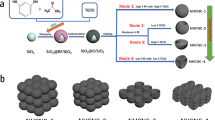Abstract
In this study, a simple route for the synthesis of hollow mesoporous carbon materials (HMCMs) with adjustable shell thicknesses via a one-pot strategy for direct carbonization and etching was developed. HMCMs were examined as a carrier matrix for the delivery of tetracycline hydrochloride (TH). The thickness of the mesoporous shell could be tuned between 7 and 90 nm by changing the amount of cetyltrimethylammonium bromide and composition of the polymer precursor. The obtained materials were characterized by transmission electron microscopy, scanning electron microscopy, X-ray diffraction, thermogravimetric analysis, and N2 adsorption–desorption isotherms. The optimum conditions for the synthesis of the HMCM spheres were systematically investigated. The synthesized materials possessed specific surface areas of 710–954 m2 g−1 and average pore diameters of 3.8 nm. The performance of the HMCMs towards the delivery of TH was tested in vitro in an aqueous bath at 37 °C; the release of TH from these drug delivery systems was monitored by UV–Vis spectroscopy. Results demonstrated that by adjusting the mesoporous carbon shell thickness of the HMCMs, high TH adsorption capacities (722–850 mg g−1) and tunable higher drug releases ranging from 15 to 25 h and sustained lower drug releases over the subsequent ~30 h were achieved.








Similar content being viewed by others
References
Regi MV, Ra´mila A, Real RP, Pariente JP (2001) A new property of MCM-41: drug delivery system. Chem Mater 13:308–311
Liu Y, Zhou L, Hu Y, Guo CF, Qian HS, Zhang FM, Lou XW (2011) Magnetic-field induced formation of 1D Fe3O4/C/CdS coaxial nanochains as highly efficient and reusable photocatalysts for water treatment. J Mater Chem 21:18359–18364
Das P, Silva AR, Carvalho AP, Pires J, Freire C (2009) Organo-functionalized mesoporous supports for Jacobsen-type catalyst: laponite versus MCM-41. J Mater Sci 44:2865–2875. doi:10.1007/s10853-009-3379-x
Liu WJ, Liu YX, Yan XY, Yong GP, Xu YP, Liu SM (2014) One-pot synthesis of yolk–shell mesoporous carbon spheres with high magnetisation and its applied in the adsorption of pyrene. J Mater Chem A 2:9600–9606
Tripathi PK, Liu MX, Gan LH, Qian JS, Xu ZJ, Zhu DZ, Rao NN (2013) High surface area ordered mesoporous carbon for high-level removal of rhodamine B. J Mater Sci 48:8003–8013. doi:10.1007/s10853-013-7612-2
Moeller-Siegert M, Parmentier J, Anselme K, Vix-Guterl C (2013) Mesoporous hydroxyapatite by hard templating of silica and carbon foams for protein release. J Mater Sci 48:3722–3730. doi:10.1007/s10853-013-7170-7
Fang Y, Gu D, Zou Y, Wu ZX, Li FY, Che RC, Deng YH, Tu B, Zhao DY (2010) A low-concentration hydrothermal synthesis of biocompatible ordered mesoporous carbon nanospheres. Angew Chem Int Ed 49:7987–7991
Kim TW, Chung PW, Slowing II, Tsunoda M, Yeung ES, Lin VSY (2008) Structurally ordered mesoporous carbon nanoparticles as transmembrane delivery vehicle in human cancer cells. Nano Lett 8:3724–3727
Guo BK, Wang XQ, Fulvio PF, Chi MF, Mahurin SM, Sun XG, Dai S (2008) Soft-templated mesoporous carbon-carbon nanotube composites for high performance lithium-ion batteries. Adv Mater 23:4661–4666
Liu HJ, Bo SH, Cui WJ, Li F, Wang CX, Xia YY (2008) Nano-sized cobalt oxide/mesoporous carbon sphere composites as negative electrode material for lithium-ion batteries. Electrochim Acta 53:6497–6503
Lou XW, Deng D, Lee JY, Archer LA (2008) Preparation of SnO2/carbon composite hollow spheres and their lithium storage properties. Chem Mater 20:6562–6566
White RJ, Tauer K, Antonietti M, Titirici MM (2010) Functional hollow carbon nanospheres by latex templating. J Am Chem Soc 132:17360–17363
Guo LM, Cui XZ, Li YS, He QJ, Zhang JG, Bu WB, Shi JL (2009) Hollow mesoporous carbon spheres with magnetic cores and their performance as separable bilirubin adsorbents. Chem-Asian J 4:1480–1485
Guo LM, Zhang LX, Zhang JM, Zhou J, He QJ, Zeng SZ, Cui XZ, Shi JL (2009) Hollow mesoporous carbon spheres—an excellent bilirubin adsorbent. Chem Commun 6071–6073
Kim SS, Pinnavaia TJ (2001) A low cost route to hexagonal meso-structured carbon molecular sieves. Chem Commun 2418–2419
Liu R, Mahurin SM, Li C, Unocic RR, Idrobo JC, Gao HJ, Pennycook SJ, Dai S (2011) Dopamine as a carbon source: the controlled synthesis of hollow carbon spheres and yolk-structured carbon nanocomposites. Angew Chem Int Ed 50:6799–6802
Konickia W, Cendrowski K, Chen XC, Mijowska E (2013) Application of hollow mesoporous carbon nanospheres as an high effective adsorbent for the fast removal of acid dyes from aqueous solutions. Chem Eng J 228:824–833
Yang SB, Feng XL, Zhi LJ, Cao Q, Maier J, Mullen S (2010) Nanographene-constructed hollow carbon spheres and their favorable electroactivity with respect to lithium storage. Adv Mater 22:838–842
Yoon SB, Sohn K, Kim JY, Shin CH, Yu JS, Hyeon T (2002) Fabrication of carbon capsules with hollow macroporous core/mesoporous shell structures. Adv Mater 14:19–21
Fu JW, Xu Q, Chen JF, Chen ZM, Huang XB, Tang XZ (2010) Controlled fabrication of uniform hollow core porous shell carbon spheres by the pyrolysis of core/shell polystyrene/cross-linked polyphosphazene composites. Chem Commun 46:6563–6565
Stöber W, Fink A, Bohn E (1968) Controlled growth of monodisperse silica spheres in the micron size range. J Colloid Interface Sci 26:62–69
Zhu J, Liao L, Bian XJ, Kong JL, Yang PY, Liu BH (2012) pH-Controlled delivery of doxorubicin to cancer cells based on small mesoporous carbon nanospheres. Small 17:2715–2720
Acknowledgements
We gratefully acknowledge the Commonwealth Scientific Foundation for Industry of Chinese Inspection and Quarantine (No. 201210071) of the Ministry of National Science and Technology of China.
Author information
Authors and Affiliations
Corresponding author
Electronic supplementary material
Below is the link to the electronic supplementary material.
Rights and permissions
About this article
Cite this article
Liu, W., Zhu, F., Liu, Y. et al. One-pot synthesis of hollow mesoporous carbon materials and their drug release properties. J Mater Sci 50, 717–724 (2015). https://doi.org/10.1007/s10853-014-8631-3
Received:
Accepted:
Published:
Issue Date:
DOI: https://doi.org/10.1007/s10853-014-8631-3




